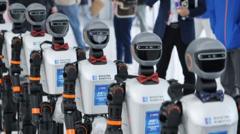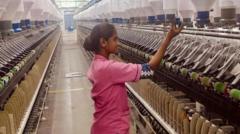With various companies innovating, the future of humanoid robots is still uncertain but full of potential.
The Race for Humanoid Robots: Who Will Prevail?

The Race for Humanoid Robots: Who Will Prevail?
Exploring the global competition in humanoid robot development.
It's a sunny spring morning in Hanover, Germany, and anticipation fills the air as I approach a humanoid robot exhibit. Here at the Hannover Messe, one of the largest industrial trade shows globally, I'm set to witness the G1, a humanoid robot developed by the Chinese company, Unitree. Standing 4'3" (130cm), the G1 is designed to be more accessible and cost-effective than many of its contemporaries, captivating audiences with its impressive dexterity as it performs tasks from dancing to martial arts.
Today, the G1 is remotely operated by Pedro Zheng, Unitree's sales manager, who explains that customers can program the robot for its autonomous functions. As attendees gather around, they eagerly interact with the G1—attempting handshakes, making funny movements to elicit reactions, and chuckling when the robot waves back or bends over. There's an inherent comfort in engaging with a machine that resembles a human, even if in a slightly uncanny way.
Unitree is among a growing list of companies globally pursuing humanoid robotics. The market potential is considerable; such robots could revolutionize industries by offering an endless workforce free from the need for breaks or salary increases. Additionally, the prospect of a humanoid robot taking care of household chores is incredibly appealing. Yet, achieving this vision is fraught with challenges.
Unlike traditional robotic arms already entrenched in factories—where conditions are safer and more controlled—getting humanoid robots to operate in unpredictable environments, such as homes and restaurants, poses significant hurdles. Strength and safety become central concerns, as any mishap could lead to hazards. The artificial intelligence (AI) driving these robots, according to Unitree, is still struggling with complex tasks and logic that humans take for granted. The G1 is currently targeted at research and development institutions where the open-source software can be rigorously tested.
For now, businesses are turning toward humanoid robots specifically tailored for warehouses and industrial applications. The most notable is Elon Musk's Tesla, which is reportedly manufacturing a humanoid robot, named Optimus, with plans to produce "several thousand" units this year for practical use within production lines. Similar ventures are popping up: BMW has rolled out humanoid robots in their factories while Hyundai has placed a substantial order with Boston Dynamics for robots to enhance their output.
Thomas Andersson, the founder of research firm STIQ, is monitoring about 49 companies involved in humanoid robot development. He emphasizes that the majority of these ventures are in Asia, due to the robust supply chain and innovative ecosystem available there. Unitree's G1 is priced competitively at $16,000 (£12,500), a factor that positions it well in the market. According to STIQ, approximately 60% of capital invested in humanoid robotics is flowing into Asian companies, benefiting from governmental support such as specialized training facilities for humanoid robots.
The question arises: how can companies in the US and Europe keep pace with this competitive landscape? Bren Pierce, based in Bristol, has founded three robotics firms, with his latest, Kinisi, recently unveiling the KR1 robot. While designed in the UK, the KR1's manufacturing is outsourced to Asia, due to the challenge of sourcing components more cost-effectively than local assemblage would allow. "It's inefficient to ship parts globally when everything can be sourced right in Asia," he explains.
Pierce's KR1 robot is specifically engineered for manufacturing settings—designed without legs, it's a cost-effective solution for businesses with flat facilities. By leveraging commonly available commercial components, such as electric scooter wheels, he simplifies both manufacturing and maintenance. "Our aim is to build a user-friendly robot so that a standard warehouse employee can operate it easily after minimal training," he adds.
As humanoid robots strive for a place in household settings, experts like Pierce concede that widespread adoption remains at least a decade away. "My goal is to create the all-encompassing robot, something I’ve envisioned throughout my doctoral studies. However, we’re still years from that reality," he muses.
With technological advancements still on the horizon, it remains to be seen which company will first achieve a humanoid robot capable of navigating both industry and home, setting the stage for the next evolution in robotics.




















